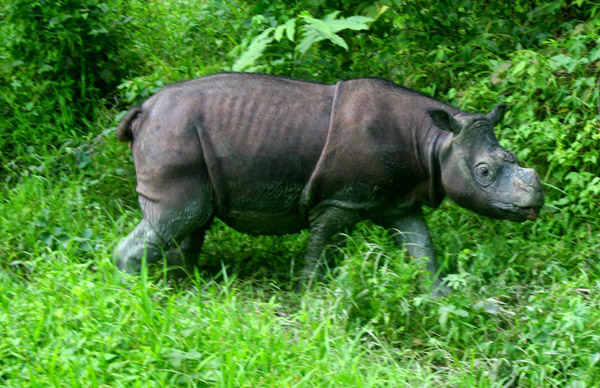- Andalas, the first rhino born at the Cincinnati Zoo, has already fathered two calves with a female at the Sumatran Rhino Sanctuary in Indonesia. Hopes are now pinned on his brother successfully breeding there too.
- Researchers in Malaysian Borneo, where the last three rhinos surviving in captivity all have fertility problems, have turned to in vitro fertilization to try and produce a calf.
- Experts say they have to be optimistic about the future, but Sumatran rhinos face daunting challenges: small numbers, low fertility, bureaucratic obstacles and questions over the wisdom of expending so many resources on so few animals.
This is the second article in two-part series about a captive breeding program attempting to rescue the Sumatran rhino (Dicerorhinus sumatrensis) from the brink of extinction. Read Part One here.

When Harapan, the third Sumatran rhino born at the Cincinnati Zoo, arrived at his new home at the Sumatran Rhino Sanctuary in Way Kambas National Park in October 2015, he joined his brother Andalas and three females named Ratu, Bina and Rosa. Ratu had given birth to a calf, Andatu, in June of 2012, and was pregnant again — she would give birth to Delilah in May 2016.
These calves represented hope for a comeback for the species and were a tribute to international cooperation. Forty rhinos were taken into captivity in 1984 in an attempt to address the species’ severe population decline, but they proved difficult to maintain and breed. Research at the Cincinnati Zoo finally resulted in the first calf, Andalas, in 2001. Andalas was sent to the Sumatran Rhino Center in 2007, where he fathered their first calves. By 2015, Harapan was the last Sumatran rhino in North America and the Cincinnati Zoo made the difficult decision to send him to Sumatra as well, where he could contribute to the continuation of his species.
The fundamental mysteries of breeding these rhinos had been solved by the time the American-born rhinos were transferred to Indonesia, but the staff at SRS still had to solve some interesting problems of their own. First among these was the soap opera of rhino family life at the sanctuary.




